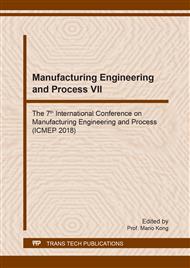[1]
D. Roylance. Introduction to Composite Materials,. Department of Materials Science and Engineering, Massachusetts Institute of Technology, Cambridge, MA. p.1 – 8, (2000).
Google Scholar
[2]
S. Kalpakjian and S.R. Schmid Manufacturing Engineering and Technology,. 4th Edition, Pearson Education, Inc., USA, (2001).
Google Scholar
[3]
N.N. Greenwood and A. Earnshaw Chemistry of the Elements,. 2nd Edition, Butterworth-Heinemann, Oxford, United Kingdom, (1997).
Google Scholar
[4]
J.B. Reeves and J.L. Weihrauch. Composition of foods: Fats and Oils., Consumer and Food Economic Institute, Agricultural Handbook. Washington D.C., US Dept. of Agriculture, Science and Education Administration, p.4, (1979).
Google Scholar
[5]
ASTM. American Standard for Testing Materials., ASTM D5865 – 02. 1978. Retrieved on 18th March 2015 at 2.30 pm.
Google Scholar
[6]
C.B. Powell, A.I. Hart and S. Deekae. Market survey of the Periwinkle Tympanotonus Fascatus in Rivers State: Sizes, Prices, Trade Routes and Exploitation Levels., Proceedings of the 4th Annual Conference of the Fisheries Society of Nigeria (FISON), Port Harcourt, Nigeria, p.55 – 61, (1985).
Google Scholar
[7]
N. Jamabo and A. Chinda. Aspects of the Ecology of Tympanotonous Fuscatus Var Fuscatus (Linnaeus, 1758) in Mangrove Swamps of the Upper Bonny River, Niger Delta, Nigeria., Current Research Journal of Biological Sciences, Vol. 2(1), p.42 – 47, (2010).
Google Scholar
[8]
A. Vogel, R.D. Doherty and B. Cantor. Stir-cast Microstructures and Slow Crack Growth., In: Proceedings of the Conference on Solidification and Casting of Metals, Sheffield, Pp. 18 – 21, (1977).
Google Scholar
[9]
S. Naher, D. Brabazon and L. Looney. Development and Assessment of a New Quick Quench Stir Caster Design for the Production of Metal Matrix Composites., Journal of Material Processing Technology, Vol. 166, p.430 – 439, (2004).
DOI: 10.1016/j.jmatprotec.2004.09.043
Google Scholar
[10]
T.A. Thomas, R. Parameshwaran, A. Muthukrishnan and A.M. Kumaran. Development of Feeding and stirring Mechanisms for Stir Casting of Aluminium Matrix Composites,, International Conference on Advances in Manufacturing and Materials Engineering, Procedia Materials Science, Vol. 5, p.1182 – 1191, (2014).
DOI: 10.1016/j.mspro.2014.07.415
Google Scholar
[11]
J. Hashim. The Production of Cast Metal Matrix Composite by a Modified Stir Casting Method., Journal of Technology, Vol. 35(A), p.9 – 20, (2001).
Google Scholar
[12]
J. Hashmi, L. Looney and M.S.J. Hashmi. Metal Matrix Composites: Production by Stir Casting Method,, Journal of Materials Processing Technology, Elsevier B.V., Netherlands, Vol. 92(93), p.1 – 7, (1999).
DOI: 10.1016/s0924-0136(99)00118-1
Google Scholar
[13]
K.P. Kevin and M.T. Sijo. Effect of Stirrer Parameter of Stir Casting on Mechanical Properties of Aluminium Silicon Carbide Composite,. International Journal of Modern Engineering Research, Vol. 5 (8), p.43 – 49, (2015).
Google Scholar
[14]
R. Ahmad, N. Hamidin, U.F.M. Ali and C.Z.A. Abidin. Characterization of Bio-Oil from Palm Kernel Shell Pyrolysis,. Journal of Mechanical Engineering and Sciences (JMES), Vol. 7, p.1134 – 1140, (2014).
DOI: 10.15282/jmes.7.2014.12.0110
Google Scholar
[15]
K. Sukumaran, S.G.K. Pillai, R.M. Pillai, V.S. Kelukutty, B.C. Pai, K.G. Satyanarayana and K.K. Ravikumar. The Effect of Mg Addition on the Structure and Properties of Al-7Si-10SiCp Composites,, Journal of Material Science, Vol. 30, p.1469 – 1472, (1995).
DOI: 10.1007/bf00375250
Google Scholar
[16]
M.H. Jokhio, M.I. Panhwar and M.A. Unar. Manufacturing of Aluminium Composite Material using Stir Casting Process,, Mehran University Research Journal of Engineering & Technology, Vol. 30 (1), p.53 – 64, (2011).
Google Scholar
[17]
P.O. Babalola, C.A. Bolu, A.O. Inegbenebor and K.M. Odunfa. Development of Aluminium Matrix Composites: A Review,. Online International Journal of Engineering and Technology Research, 2, pp.1-11, (2014).
Google Scholar
[18]
K.K. Alaneme and M.O. Bodunrin. Mechanical Behaviour of Alumina Reinforced AA 6063 Metal Matrix Composites Developed by Two Step – Stir Casting Process,. Bulletin of Engineering, Tome IV, Fascicule 3, (2013).
Google Scholar


